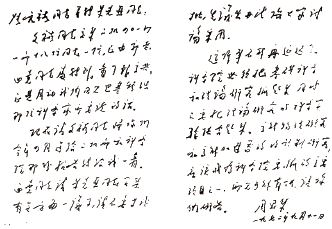IHEP’s history goes back to the early days of the People’s Republic of China, when the Institute of Modern Physics was established in 1950. This was later renamed the Institute of Physics and then the Institute of Atomic Energy. IHEP itself began life as Division One of the Institute of Atomic Energy. After Premier Zhou Enlai highlighted high energy physics as a priority for the Chinese Academy of Sciences, IHEP was split off as a separate research institute, and officially established in February 1973. The first Director was Zhang Wenyu.
Since then, IHEP has grown from its humble beginnings to become one of China’s biggest research institutes and a major player in the international particle physics community, as well as hosting experiments for fields from materials science to biology.
The timeline below highlights some of the major events in IHEP’s history.
- In September 1972, Premier Zhou Enlai wrote to Zhang Wenyu and Zhu Guangya that "This issue should not be delayed any further.The study of high energy physics and the R&D of a high energy accelerator should be one of the main projects of the CAS.”

- On October 16, 1988, the first electron-positron collisions took place at BEPC. Deng Xiaoping and other Party and State leaders inspected the BEPC project and extended their regards to the builders. Deng made the important remark, "China must develop its own advanced technology and take its place in the world arena of high technology".

- In January 1990, the air shower array for observing ultra-high energy γ-rays at Yangbajing, Tibet, commenced operations with 44 detectors operating around the clock, recording shower events incurred by ultra-high energy cosmic rays.
- In September 1991, the Beijing Synchrotron Radiation Facility (BSRF) was opened to domestic users.
- In March 1992, BES published its first physics paper, on the precision measurement of the tau mass, which removed doubts about lepton universality.
- In December 1993, the Beijing Free-Electron Laser (BFEL), the first of its kind in Asia, reached lasing saturation.
- In November 1994, the expansion of the Yangbajing cosmic ray experimental station for the Sino-Japanese collaboration was completed, with the extended air shower array covering an area of 60,000 square meters, one of the world’s four biggest arraysfor the research of high energy γ astronomy and cosmic rays.
- In February 1999, the BEPC/BES/BSRF upgrade plans successfully passed appraisal.
- In July 2000, the Science and Technology Group of the State Council examined and passed the Report on the Development Goals of China's High Energy Physics and Advanced Accelerators. It also approved the upgrade of BEPC.
- In December 2003, the National Development and Reform Commission officially approved the BEPC Upgrade Project.
- In January 2004, the BEPC Upgrade Project kicked off.
- In October 2007, construction of the Daya Bay Reactor Neutrino Experiment began.
- In July 2008, the first collisions took place at BEPCII, the upgraded BEPC, and were observed by the new BESIII detector.
- In September 2008, the China Spallation Neutron Source Project was approved by the National Development and Reform Commission.
- In July 2009, the Upgrade Project, BEPCII, successfully passed the National Acceptance Test organized by the National Development and Reform Commission, which marked the successful completion of the Upgrade on schedule, within budget and at high quality.
- In October 2011, the inauguration ceremony for the China Spallation Neutron Source Project was held in Dongguan, Guangdong Province.
- In March 2012, the Daya Bay Reactor Neutrino Experiment announced the discovery of a new type of neutrino oscillation. The Daya Bay collaboration’s first results indicated that θ13, expressed as sin22θ13, is equal to 0.092 plus or minus 0.017.
- On December 20, 2012, the discovery of of the θ13 neutrino oscillation by the Daya Bay Reactor Neutrino Experiment was selected as one of the Top Ten Breakthroughs of the Year 2012 by Science.
- In March 2013, the BESIII Collaboration reported that the Y(4260) particle can decay to a new, and perhaps even more mysterious, particle named the "Zc(3900).”
- In July, 2013, President Xi Jinping visited IHEP
- In January, 2014, the CAS Innovation Center for Particle Physics Frontiers was founded, and the center was based at IHEP.
- In December, 2015, the National Development and Reform Commission, China’s top economic planning body, approved the Large High Altitude Air Shower Observatory (LHAASO) project.
- In April, 2016, BEPCII luminosity reached its design parameters of 1×1033cm-2s-1 at an energy of 1.89 GeV